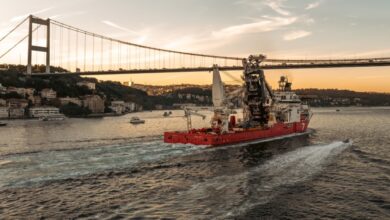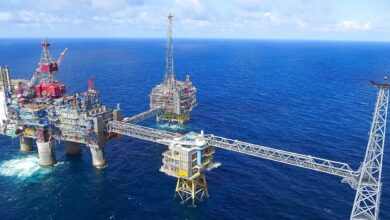Drilling automation: No more a pipe dream, not yet a practicality
 When it comes to automation of the drilling process, the industry is at once eager yet timid, excited yet uncomfortable. We seem to be right at the door of something great, something that could lead to significant improvements in efficiency and safety, but most people are still only willing to put one foot through the door.
When it comes to automation of the drilling process, the industry is at once eager yet timid, excited yet uncomfortable. We seem to be right at the door of something great, something that could lead to significant improvements in efficiency and safety, but most people are still only willing to put one foot through the door.

“It makes us uncomfortable to hand operations over to computers because the industry has yet to build a lot of faith in automation,” said panelist David Payne, Chevron VP global drilling & completions, during the final plenary session at the 2010 IADC/SPE Drilling Conference in New Orleans on 4 February. “In some areas, it’s made it safer. In other areas, it’s actually brought additional risks into the system.”
He added that he does support automation going forward. One reason is that it takes out much of the variability that comes with human error. “When you’re doing a routine operation, it’s not uncommon for people to lose focus and make mistakes that can get us in a bind, cost us a lot of money or get someone hurt,” he said.

Lyndol Dew, Diamond Offshore senior vice president of worldwide operations, took the view that mechanization is currently still a better route than automation. “Mechanization delivers the goods, whereas automation, under today’s technology, is in some ways an impediment of efficiencies,” he said.
There’s also a “loss of control” factor that makes drilling contractors hesitant to fully embrace automation. Although equipment manufacturers do a great job of designing automated equipment, Mr Dew continued, that equipment still has to go through software engineers before it can go to work on a rig. “The codes for the software are not open to us. They’re proprietary and, in many cases, we don’t have control over that.”
Additionally, the industry is still learning to deal with the costs and inconvenience of obsolescence – an unavoidable aspect of anything related to software and computers, it seems. “We have wholesale replacement of this equipment when it’s only 5 years old, which is something we hadn’t come to grips with in the past,” Mr Dew said.
Because personnel is a major cost driver for contractors, the fact that automation equipment requires a host of specialized engineering experts onboard the rig is another barrier, Mr Dew said. Automation hasn’t reduced the number of people needed onboard at all, as initially promised. “No matter how many beds you build (on the rig) … if you build it, they will come.”

Panelist Hermann Spoerker, OMV E&P, addressed his concerns about the lack of standards for software in the drilling industry. “My feeling is that, compared to the computer industry, we are in the pre-MS DOS era. We don’t even have the common platform to write software,” he said. To truly open the market for development, the industry might need the same level of standardization that Microsoft gave computers.
Mr Spoerker also emphasized the difference between automation of the drilling process and automation of the machinery working on surface. “It’s great to have the pipe handler automated. It’s a great thing to have your makeup/breakout machine automated. All that’s great, but, in the end, the drilling process is about more than that.”
He continued: “The moment we talk about automating something below the rotary table, we all get very hesitant.”
If there was one button to push that would let the machine automatically pull out of hole at 6,000 meters and call you when the bit is on surface, would you be willing to push that button? Mr Spoerker doesn’t think so: “None of us would be willing to push the button and trust the well to this automatic controller.”
Pat Mannina, Oceaneering vice president and general manager of the Americas region and ROV service line, discussed drilling automation from the perspective of a provider of ROV technology, which has come a long way since its commercialization in the 1970s. “Back in those days, the expectations for ROVs were pretty low. If the ROV worked for an hour straight, it was considered a success. In today’s environment, if you have an hour of downtime, shame on you – and you’ll hear about it,” he said.
During the session, one question posed to the audience was on what “automation of the drilling process” is. The audience response, taken by electronic voting pads, revealed that 83% believed automation is “a valuable tool for improving safety.” A total 12% said automation is “an accident waiting to happen,” while 4% said it’s “not worth pursuing.”
These numbers prompted this comment from Mr Spoerker: “I am curious, if we have something like 80% of the people in the room saying that automation is a valuable tool to improve safe operations, why is it so difficult to get automation out on the rigs?”
Are operators really seeing the value of automation or is it just “lip service”? “We believe automation is great, but the moment you go out to tender, you still select the lower-quality rig that doesn’t have the full automation because you say, ‘We’re going to be able to make do without all the automation,’ ” he continued.
For the drilling managers who are willing to pay a higher dayrate for highly automated rigs, there have been very few statistics or case studies that they could use to show the actual advantages of automation on rigs. “What do we give that poor guy to defend his position when he stands up in front of his executive VP?” Mr Spoerker remarked.
Mr Payne responded to Mr Spoerker’s comment, however, by asserting that the operator community has in fact recognized the value of safety. He pointed to the success of the highly automated FlexRigs in the North American land drilling market.
“If you look at onshore North America, this is probably the most difficult business to be in at the moment. Low gas prices, margins are low, we’ve seen a lot of layoffs. There’s 1,000 stacked rigs in North America right now, and you can’t get a FlexRig” even though they cost $5,000 to $8,000 more per day, Mr Payne said. That’s a significant amount of money on a land operation, he added.
“The fact that there’s not a FlexRig available tells me the whole industry’s recognized, ‘Hey, there’s real value in that new technology.’ I think what’s slowed us down is we have not been as engaged, from an operator’s perspective, in some of the newbuild activity. We have not stepped up and gotten in early. The jackup refresh that’s happened in the industry is a great example of that. There’s been absolutely no input that I know of from operators in what comes out of shipyards with these jackups … and now the opportunity to build something new just isn’t there because the market’s flushed,” Mr Payne said.

Later in the session, in response to an audience question referring to big semiconductor companies forming a consortium to overcome their industry’s standardization challenges, Mr Payne mentioned that he has had a discussion with a major service company about undertaking something similar through API. API publishes standards for everything from drill pipe to casing to wellheads – why not software? “And it goes beyond just mechanization or automation. We don’t have standardization around databases and those sorts of things. We’ve got a proliferation of opportunities in the IT space to really improve in our business.”
The session was moderated by Tim Juran, senior vice president for Seadrill.




